Global Review of International Nuclear Waste Management
Abstract
:1. Introduction
2. Methodology
3. Results
4. Discussion
5. Conclusions
Author Contributions
Funding
Data Availability Statement
Conflicts of Interest
References
- Harbiankova, A.; Kalinowski, S. MSW Management to Zero Waste: Challenges and Perspectives in Belarus. Sustainability 2023, 15, 2012. [Google Scholar] [CrossRef]
- Walsh, E.J. New dimensions of social movements: The high-level waste-siting controversy. Sociol. Forum 1988, 3, 586–605. [Google Scholar] [CrossRef]
- Hamilton, J.T. Politics and Social Costs: Estimating the Impact of Collective Action on Hazardous Waste Facilities. RAND J. Econ. 1993, 24, 101–125. [Google Scholar] [CrossRef]
- Behrsin, I. Controversies of justice, scale, and siting: The uneven discourse of renewability in Austrian waste-to-energy development. Energy Res. Soc. Sci. 2020, 59, 101252. [Google Scholar] [CrossRef]
- Mazur, A.; Conant, B. Controversy over a Local Nuclear Waste Repository. Soc. Stud. Sci. 1978, 8, 235–243. [Google Scholar] [CrossRef]
- Solomon, B.D.; Andrén, M.; Strandberg, U. Three Decades of Social Science Research on High-Level Nuclear Waste: Achievements and Future Challenges. Risk Hazards Crisis Public Policy 2010, 1, 13–47. [Google Scholar] [CrossRef]
- Kharecha, P.A.; Hansen, J.E. Prevented mortality and greenhouse gas emissions from historical and projected nuclear power. Environ. Sci. Technol. 2013, 47, 4889–4895. [Google Scholar] [CrossRef]
- Schneider, M.; Froggatt, A. 2012–2013 world nuclear industry status report. Bull. At. Sci. 2014, 70, 70–84. [Google Scholar] [CrossRef]
- Michael, E.K.; Eugene, A.R.; Dunlap, R.E. Public Opinion and Nuclear Waste Policymaking. In Public Reactions to Nuclear Waste: Citizens’ Views of Repository Siting; Dunlap, R.E., Kraft, M.E., Rosa, E.A., Eds.; Duke University Press: Durham, NC, USA, 1993; pp. 3–31. [Google Scholar]
- Hosan, M.I. Radioactive Waste Classification, Management and Environment. Eng. Int. 2017, 5, 53–62. [Google Scholar] [CrossRef]
- An, N.; Cui, Y.J.; Conil, N.; Talandier, J.; Conil, S. Soil–atmosphere interaction in the overburden of a short-lived low and intermediate level nuclear waste (LLW/ILW) disposal facility. Comput. Geotech. 2020, 124, 103610. [Google Scholar] [CrossRef]
- Ojovan, M.I.; Steinmetz, H.J. Approaches to Disposal of Nuclear Waste. Energies 2022, 15, 7804. [Google Scholar] [CrossRef]
- International Atomic Energy Agency (IAEA). Classification of Radioactive Waste, IAEA Safety Standards Series No. GSG-1, IAEA, Vienna. 2009. Available online: https://www.iaea.org/publications/8154/classification-of-radioactive-waste (accessed on 22 May 2023).
- Oettingen, M. Assessment of the Radiotoxicity of Spent Nuclear Fuel from a Fleet of PWR Reactors. Energies 2021, 14, 3094. [Google Scholar] [CrossRef]
- Raj, K.; Prasad, K.K.; Bansal, N.K. Radioactive waste management practices in India. Nucl. Eng. Des 2006, 236, 914–930. [Google Scholar] [CrossRef]
- Vienna, J.D. Nuclear Waste Vitrification in the United States: Recent Developments and Future Options. Int. J. Appl. Glass Sci. 2010, 1, 309–321. [Google Scholar] [CrossRef]
- Federovich, E.D. Technical Issues of Wet and Dry Storage Facilities for Spent Nuclear Fuel. In Safety Related Issues of Spent Nuclear Fuel Storage; Lambert, J.D.B., Kadyrzhanov, K.K., Eds.; NATO Science for Peace and Security Series C: Environmental Security; Springer: Dordrecht, The Netherlands, 2007. [Google Scholar] [CrossRef]
- Wang, L.; Liang, T. Ceramics for high level radioactive waste solidification. J. Adv. Ceram. 2012, 1, 194–203. [Google Scholar] [CrossRef]
- Fernández-Arias, P.; Vergara, D.; Antón-Sancho, Á. Bibliometric Review and Technical Summary of PWR Small Modular Reactors. Energies 2023, 16, 5168. [Google Scholar] [CrossRef]
- International Atomic Energy Agency (IAEA). Power Reactor Information System (PRIS). Available online: https://www.iaea.org/PRIS/home.aspx (accessed on 18 May 2023).
- Fernández-Arias, P.; Vergara, D.; Orosa, J.A. A Global Review of PWR Nuclear Power Plants. Appl. Sci. 2020, 10, 4434. [Google Scholar] [CrossRef]
- Dey, P.K.; Bansal, N.K. Spent fuel reprocessing: A vital link in Indian nuclear power program. Nucl. Eng. Des. 2006, 236, 723–729. [Google Scholar] [CrossRef]
- Luykx, F.; Fraser, G. Tritium Releases from Nuclear Power Plants and Nuclear Fuel Reprocessing Plants. Radiat. Prot. Dosim. 1986, 16, 31–36. [Google Scholar] [CrossRef]
- Natarajan, R. Reprocessing of spent nuclear fuel in India: Present challenges and future programme. Prog. Nucl. Energy 2017, 101, 118–132. [Google Scholar] [CrossRef]
- Alwaeli, M.; Mannheim, V. Investigation into the Current State of Nuclear Energy and Nuclear Waste Management—A State-of-the-Art Review. Energies 2022, 15, 4275. [Google Scholar] [CrossRef]
- Hyatt, N.C. Plutonium management policy in the United Kingdom: The need for a dual track strategy. Energy Policy 2017, 101, 303–309. [Google Scholar] [CrossRef]
- Yue, Q.; He, J.; Stamford, L.; Azapagic, A. Nuclear power in China: An analysis of the current and near-future uranium flows. Energy Technol. 2017, 5, 681. [Google Scholar] [CrossRef]
- Zhongyang, L.; Chunhua, C.; Shengpeng, Y.; Bin, W.; Lijuan, H.; Jin, W.; Yican, W. Safety evaluation of spent fuel road transportation based on weighted nearest neighbor method. Ann. Nucl. Energy 2019, 127, 412–418. [Google Scholar] [CrossRef]
- Qi, Z.; Yang, Z.; Li, J.; Guo, Y.; Yang, G.; Yu, Y.; Zhang, J. The Advancement of Neutron-Shielding Materials for the Transportation and Storage of Spent Nuclear Fuel. Materials 2022, 15, 3255. [Google Scholar] [CrossRef]
- Fu, W.; Li, X.; Wu, X.; Zhang, Z. Investigation of a long term passive cooling system using two-phase thermosyphon loops for the nuclear reactor spent fuel pool. Ann. Nucl. Energy 2015, 85, 346–356. [Google Scholar] [CrossRef]
- Jeong, J.; Cho, D.K.; Choi, H.J.; Choi, J.W. Comparison of the transportation risks for the spent fuel in Korea for different transportation scenarios. Ann. Nucl. Energy 2011, 38, 535–539. [Google Scholar] [CrossRef]
- Perrotta, J.A.; Terremoto, L.A.A.; Zeituni, C.A. Experience on wet storage spent fuel sipping at IEA-R1 Brazilian research reactor. Ann. Nucl. Energy 1998, 25, 237–258. [Google Scholar] [CrossRef]
- Cho, C.-H.; Kim, T.-M.; Seong, K.Y.; Kim, H.-J.; Yoon, J.-H. Cost comparisons of wet and dry interim storage facilities for PWR spent nuclear fuel in Korea. Ann. Nucl. Energy 2011, 38, 976–981. [Google Scholar] [CrossRef]
- Kook, D.; Choi, J.; Kim, J.; Kim, Y. Review of spent fuel integrity evaluation for dry storage. Nucl. Eng. Tech. 2013, 45, 115–124. [Google Scholar] [CrossRef]
- El-Samrah, M.G.; Tawfic, A.F.; Chidiac, S.E. Spent nuclear fuel interim dry storage; Design requirements, most common methods, and evolution: A review. Ann. Nucl. Energy 2021, 160, 108408. [Google Scholar] [CrossRef]
- Wegel, S.; Czempinski, V.; Oei, P.-Y.; Wealer, B. Transporting and Storing High-Level Nuclear Waste in the U.S.—Insights from a Mathematical Model. Appl. Sci. 2019, 9, 2437. [Google Scholar] [CrossRef]
- Rodríguez-Penalonga, L.; Moratilla Soria, B.Y. A Review of the Nuclear Fuel Cycle Strategies and the Spent Nuclear Fuel Management Technologies. Energies 2017, 10, 1235. [Google Scholar] [CrossRef]
- Xu, Y.; Kang, J.; Yuan, J. The Prospective of Nuclear Power in China. Sustainability 2018, 10, 2086. [Google Scholar] [CrossRef]
- Fernández-Arias, P.; Vergara, D. Nuclear waste management in Spain: Analysis of the current situation and alternative strategies. Dyna 2021, 96, 355–358. [Google Scholar] [CrossRef] [PubMed]
- Hall, D.S.; Behazin, M.; Binns, W.J.; Keech, P.G. An evaluation of corrosion processes affecting copper-coated nuclear waste containers in a deep geological repository. Prog. Mater. Sci. 2021, 118, 100766. [Google Scholar] [CrossRef]
- King, F.; Hall, D.S.; Keech, P.G. Nature of the near-field environment in a deep geological repository and the implications for the corrosion behaviour of the container. Corros. Eng. Sci. Tech. 2017, 52, 25–30. [Google Scholar] [CrossRef]
- Johnson, B.; Newman, A.; King, J. Optimizing high-level nuclear waste disposal within a deep geologic repository. Ann. Oper. Res. 2017, 253, 733–755. [Google Scholar] [CrossRef]
- Tochaikul, G.; Phattanasub, A.; Khemkham, P.; Saengthamthawee, K.; Danthanavat, N.; Moonkum, N. Radioactive waste treatment technology: A review. Kerntechnik 2022, 87, 208–225. [Google Scholar] [CrossRef]
- Kurniawan, T.A.; Othman, M.H.D.; Singh, D.; Avtar, R.; Hwang, G.H.; Setiadi, T.; Lo, W.-H. Technological solutions for long-term storage of partially used nuclear waste: A critical review. Ann. Nucl. Energy 2022, 166, 108736. [Google Scholar] [CrossRef]
- Sant’ana, L.P.; Cordeiro, T. Management of radioactive waste: A review. Proc. Int. Acad. Ecol. Environ. Sci. 2016, 6, 38. [Google Scholar]
- Drace, Z.; Ojovan, M.I.; Samanta, S.K. Challenges in Planning of Integrated Nuclear Waste Management. Sustainability 2022, 14, 14204. [Google Scholar] [CrossRef]
- Maringer, F.J.; Šuráň, J.; Kovář, P.; Chauvenet, B.; Peyres, V.; García-Toraño, E.; Cozzella, M.L.; De Felice, P.; Vodenik, B.; Hult, M.; et al. Radioactive waste management: Review on clearance levels and acceptance criteria legislation, requirements and standards. Appl. Radiat. Isot. 2013, 81, 255–260. [Google Scholar] [CrossRef]
- Suh, J.W.; Sohn, S.Y.; Lee, B.K. Patent clustering and network analyses to explore nuclear waste management technologies. Energy Policy 2020, 146, 111794. [Google Scholar] [CrossRef]
- Ambashta, R.D.; Sillanpää, M.E.T. Membrane purification in radioactive waste management: A short review. J. Environ. Radioact. 2012, 105, 76–84. [Google Scholar] [CrossRef] [PubMed]
- Kovarik, P.; Navratil, J.D.; John, J. Scientific and Engineering Literature Mini Review of Molten Salt Oxidation for Radioactive Waste Treatment and Organic Compound Gasification as well as Spent Salt Treatment. Sci. Tech. Nucl. Install. 2015, 2015, 407842. [Google Scholar] [CrossRef]
- Sandri, S.; Contessa, G.M.; D’Arienzo, M.; Guardati, M.; Guarracino, M.; Poggi, C.; Villari, R. A Review of Radioactive Wastes Production and Potential Environmental Releases at Experimental Nuclear Fusion Facilities. Environments 2020, 7, 6. [Google Scholar] [CrossRef]
- Chen, H.; Jiang, W.; Yang, Y.; Man, X.; Tang, M. A bibliometric analysis of waste management research during the period 1997–2014. Scientometrics 2015, 105, 1005–1018. [Google Scholar] [CrossRef]
- Diaz-Maurin, F.; Sun, H.; Yu, J.; Ewing, R. Evolution and Structure of the Scientific Basis for Nuclear Waste Management. MRS Advances 2019, 4, 959–964. [Google Scholar] [CrossRef]
- Falagas, M.E.; Pitsouni, E.I.; Malietzis, G.A.; Pappas, G. Comparison of PubMed, Scopus, Web of Science, and Google Scholar: Strengths and weaknesses. FASEB J. 2008, 22, 338–342. [Google Scholar] [CrossRef]
- Burnham, J.F. Scopus database: A review. Biomed. Digit. Libr. 2006, 3, 1. [Google Scholar] [CrossRef]
- Meho, L.I.; Rogers, Y. Citation counting, citation ranking, and h-index of human-computer interaction researchers: A comparison of Scopus and Web of Science. J. Am. Soc. Inf. Sci. 2008, 59, 1711–1726. [Google Scholar] [CrossRef]
- Pranckutė, R. Web of Science (WoS) and Scopus: The Titans of Bibliographic Information in Today’s Academic World. Publications 2021, 9, 12. [Google Scholar] [CrossRef]
- Aguilar, S.; Telles, G.R.; Medina, P.; Quaresma, B.; Cyrino, F.L.; Castro, R. Wind power generation: A review and a research agenda. J. Clean. Prod. 2019, 218, 850–870. [Google Scholar] [CrossRef]
- Cavalcante, W.Q.d.F.; Coelho, A.; Bairrada, C.M. Sustainability and Tourism Marketing: A Bibliometric Analysis of Publications between 1997 and 2020 Using VOSviewer Software. Sustainability 2021, 13, 4987. [Google Scholar] [CrossRef]
- Van Eck, N.J.; Waltman, L. Software survey: VOSviewer, a computer program for bibliometric mapping. Scientometrics 2010, 84, 523–538. [Google Scholar] [CrossRef] [PubMed]
- Cruz-Cárdenas, J.; Zabelina, E.; Guadalupe-Lanas, J.; Palacio-Fierro, A.; Ramos-Galarza, C. COVID-19, consumer behavior, technology, and society: A literature review and bibliometric analysis. Technol. Forecast. Soc. Chang. 2021, 173, 121179. [Google Scholar] [CrossRef]
- Tamala, J.K.; Maramag, E.I.; Simeon, K.A.; Ignacio, J.J. A bibliometric analysis of sustainable oil and gas production research using VOSviewer. Clean. Eng. Technol. 2022, 7, 100437. [Google Scholar] [CrossRef]
- Cockcroft, J. The United Kingdom atomic energy authority and its functions. Br. J. Appl. Phys. 1956, 7, 43–51. [Google Scholar] [CrossRef]
- Scanlon, B.R.; Keese, K.E.; Flint, A.L.; Flint, L.E.; Gaye, C.B.; Edmunds, W.M.; Simmers, I. Global synthesis of groundwater recharge in semiarid and arid regions. Hydrol. Process. 2006, 20, 3335–3370. [Google Scholar] [CrossRef]
- Tayibi, H.; Choura, M.; López, F.A.; Alguacil, F.J.; López-Delgado, A. Environmental impact and management of phosphogypsum. J. Environ. Manag. 2009, 90, 2377–2386. [Google Scholar] [CrossRef]
- Ewing, R.C.; Weber, W.J.; Clinard, F.W. Radiation effects in nuclear waste forms for high-level radioactive waste. Prog. Nucl. Energy 1995, 29, 63–127. [Google Scholar] [CrossRef]
- International Atomic Energy Agency (IAEA). Nuclear Power Reactors in the World, Reference Data Series No. 2; IAEA: Vienna, Austria, 2021. [Google Scholar]
- Eash-Gates, P.; Klemun, M.M.; Kavlak, G.; McNerney, J.; Buongiorno, J.; Trancik, J.E. Sources of Cost Overrun in Nuclear Power Plant Construction Call for a New Approach to Engineering Design. Joule 2020, 4, 2348–2373. [Google Scholar] [CrossRef]
- Kim, S.H.; Taiwo, T.A.; Dixon, B.W. The Carbon Value of Nuclear Power Plant Lifetime Extensions in the United States. Nucl. Technol. 2022, 208, 775–793. [Google Scholar] [CrossRef]
- Wittneben, B.B.F. The impact of the Fukushima nuclear accident on European energy policy. Environ. Sci. Policy 2012, 15, 1–3. [Google Scholar] [CrossRef]
- Lechtenböhmer, S.; Samadi, S. Blown by the wind. Replacing nuclear power in German electricity generation. Environ. Sci. Policy 2013, 25, 234–241. [Google Scholar] [CrossRef]
- Meyer, T. Relational territoriality and the spatial embeddedness of nuclear energy: A comparison of two nuclear power plants in Germany and France. Energy Res. Soc. Sci. 2021, 71, 101823. [Google Scholar] [CrossRef]
- Grubler, A. The costs of the French nuclear scale-up: A case of negative learning by doing. Energy Policy 2010, 38, 5174–5188. [Google Scholar] [CrossRef]
- Pata, U.K.; Samour, A. Do renewable and nuclear energy enhance environmental quality in France? A new EKC approach with the load capacity factor. Prog. Nucl. Energy 2022, 149, 104249. [Google Scholar] [CrossRef]
- Oberloskamp, E. Ambiguities of transnationalism: Social opposition to the civil use of nuclear power in the United Kingdom and in West Germany during the 1970s. Eur. Rev. Hist./Rev. Eur. 2022, 29, 417–451. [Google Scholar] [CrossRef]
- Rafindadi, A.A.; Mika’Ilu, A.S. Sustainable energy consumption and capital formation: Empirical evidence from the developed financial market of the United Kingdom. Sustain. Energy Technol. Assess. 2019, 35, 265–277. [Google Scholar] [CrossRef]
- Kaiser, W. Destined to Brexit? British Pathways to Membership in the European Communities 1945–73. Glob. Policy 2022, 13, 9–19. [Google Scholar] [CrossRef]
- Oettingen, M. Modelling of the reactor cycle cost for thorium-fuelled PWR and environmental aspects of a nuclear fuel cycle. Geology Geophys. Environ. 2019, 45, 207. [Google Scholar] [CrossRef]
- Černoch, F.; Zapletalová, V. Hinkley point C: A new chance for nuclear power plant construction in central Europe? Energy Policy 2015, 83, 165–168. [Google Scholar] [CrossRef]
- Xu, Y.C. Nuclear energy in China: Contested regimes. Energy 2008, 33, 1197–1205. [Google Scholar] [CrossRef]
- Taebi, B.; Kloosterman, J.L. To Recycle or Not to Recycle? An Intergenerational Approach to Nuclear Fuel Cycles. Sci. Eng. Ethics 2008, 14, 177–200. [Google Scholar] [CrossRef]
- International Atomic Energy Agency (IAEA). Status and Trends in Spent Fuel and Radioactive Waste Management, IAEA Nuclear Energy Series No. NW-T-1.14 (Rev. 1), IAEA, Vienna. 2022. Available online: https://www.iaea.org/publications/14739/status-and-trends-in-spent-fuel-and-radioactive-waste-management (accessed on 25 May 2023).
- Wealer, B.; Seidel, J.P.; Hirschhausen, C. Decommissioning of nuclear power plants and storage of nuclear waste: Experiences from Germany, France, and the UK. In Technological and Economic Future of Nuclear Power; Springer: Berlin/Heidelberg, Germany, 2019; pp. 261–286. [Google Scholar]
- Richardson, S.; Danel, P.; Boutard, P.; Barrelier, P.; Viel, J.-F.; Malet, M.; Reman, O.; Carré, A. Childhood leukemia incidence in the vicinity of La Hague nuclear-waste reprocessing facility (France). Cancer Causes Control. 1993, 4, 341–343. [Google Scholar] [CrossRef]
- Lefevre, J.F. Nuclear Waste Management Policy in France. Nucl. Tech. 2017, 61, 455–459. [Google Scholar] [CrossRef]
- Raj, B.; Vasudeva, P.R. Plutonium reprocessing, breeder reactors, and decades of debate. Bull. At. Sci. 2015, 71, 14–17. [Google Scholar] [CrossRef]
- Lehtonen, M.; Kojo, M.; Jartti, T.; Litmanen, T.; Kari, M. The roles of the state and social licence to operate? Lessons from nuclear waste management in Finland, France, and Sweden. Energy Res. Soc. Sci. 2020, 61, 101353. [Google Scholar] [CrossRef]
- Chen, J.; Wei, M.; Liu, X.; Wang, J. Back-end of nuclear fuel cycle in China. Prog. Nucl. Energy 2012, 54, 46–48. [Google Scholar] [CrossRef]
- Wang, J. High-level radioactive waste disposal in China: Update 2010. J. Rock Mech. Geotech. Engin. 2010, 2, 1–11. [Google Scholar]
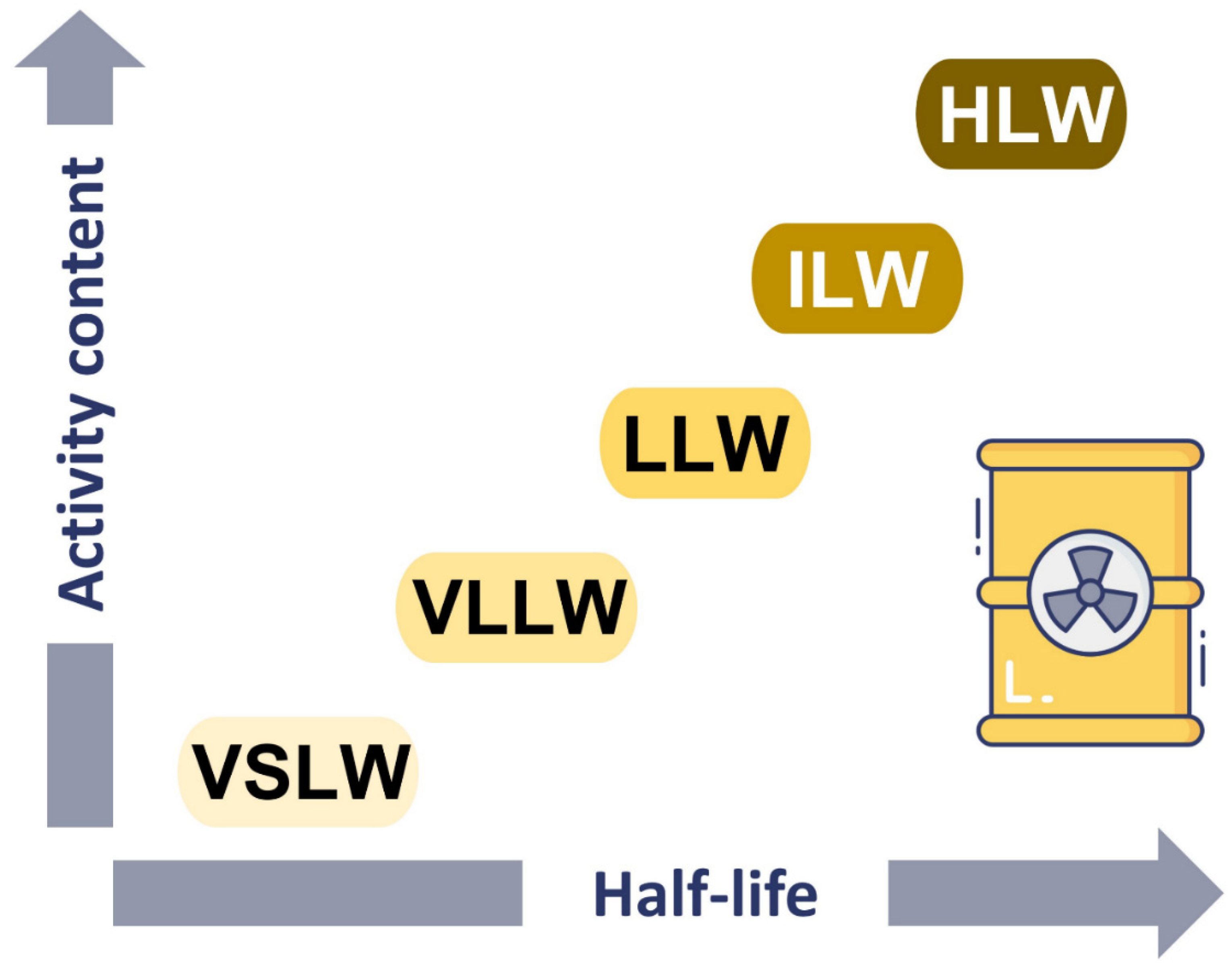

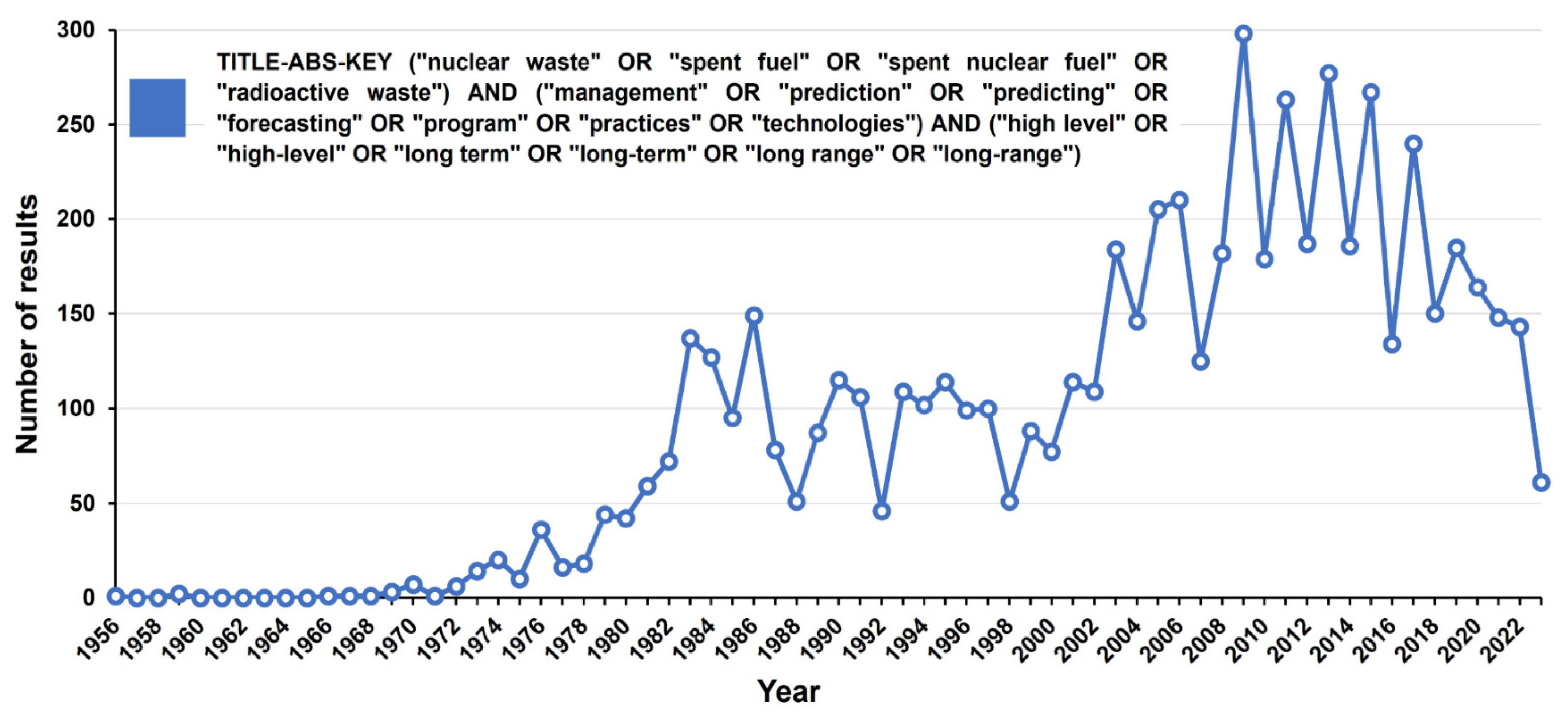
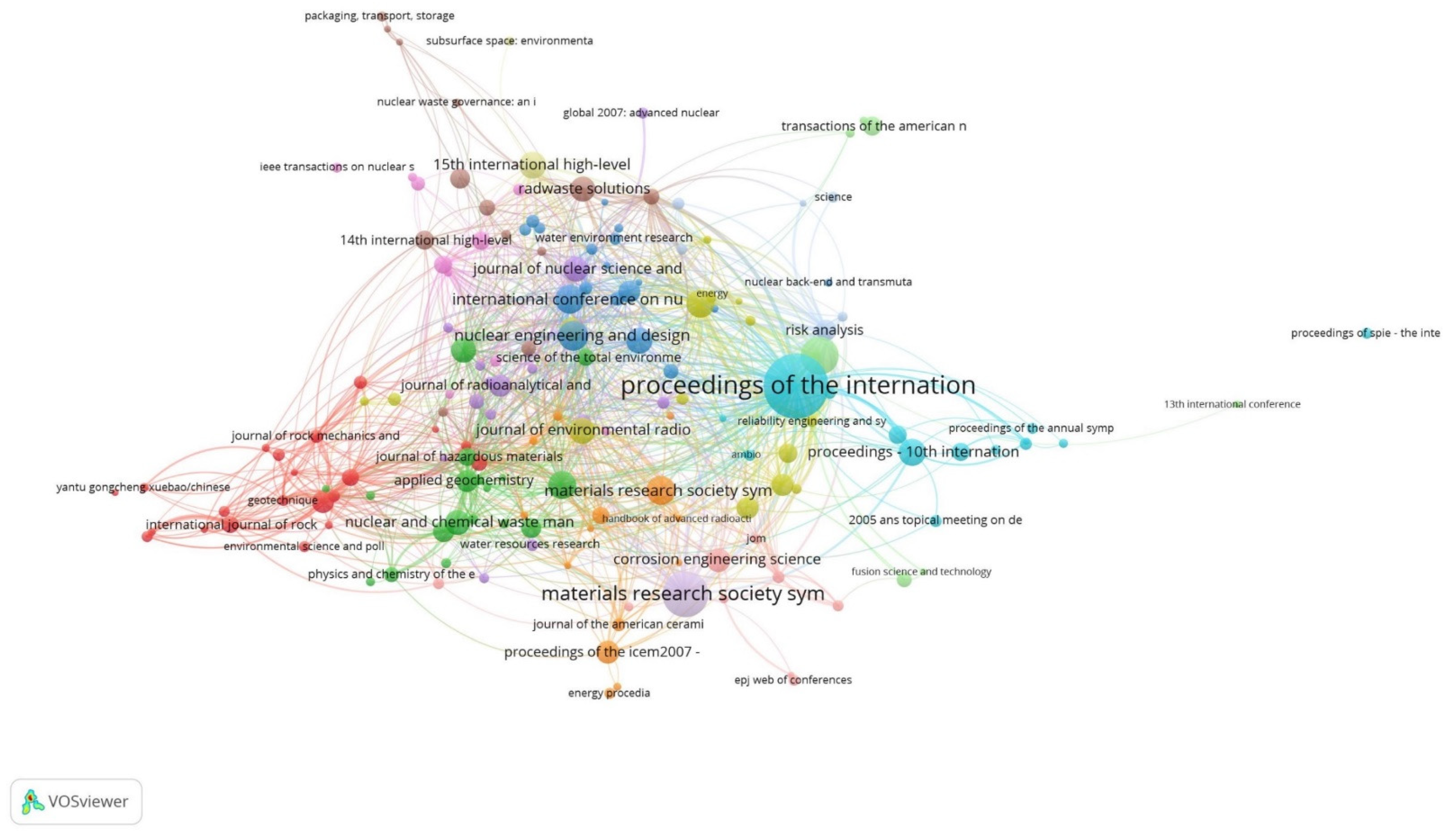
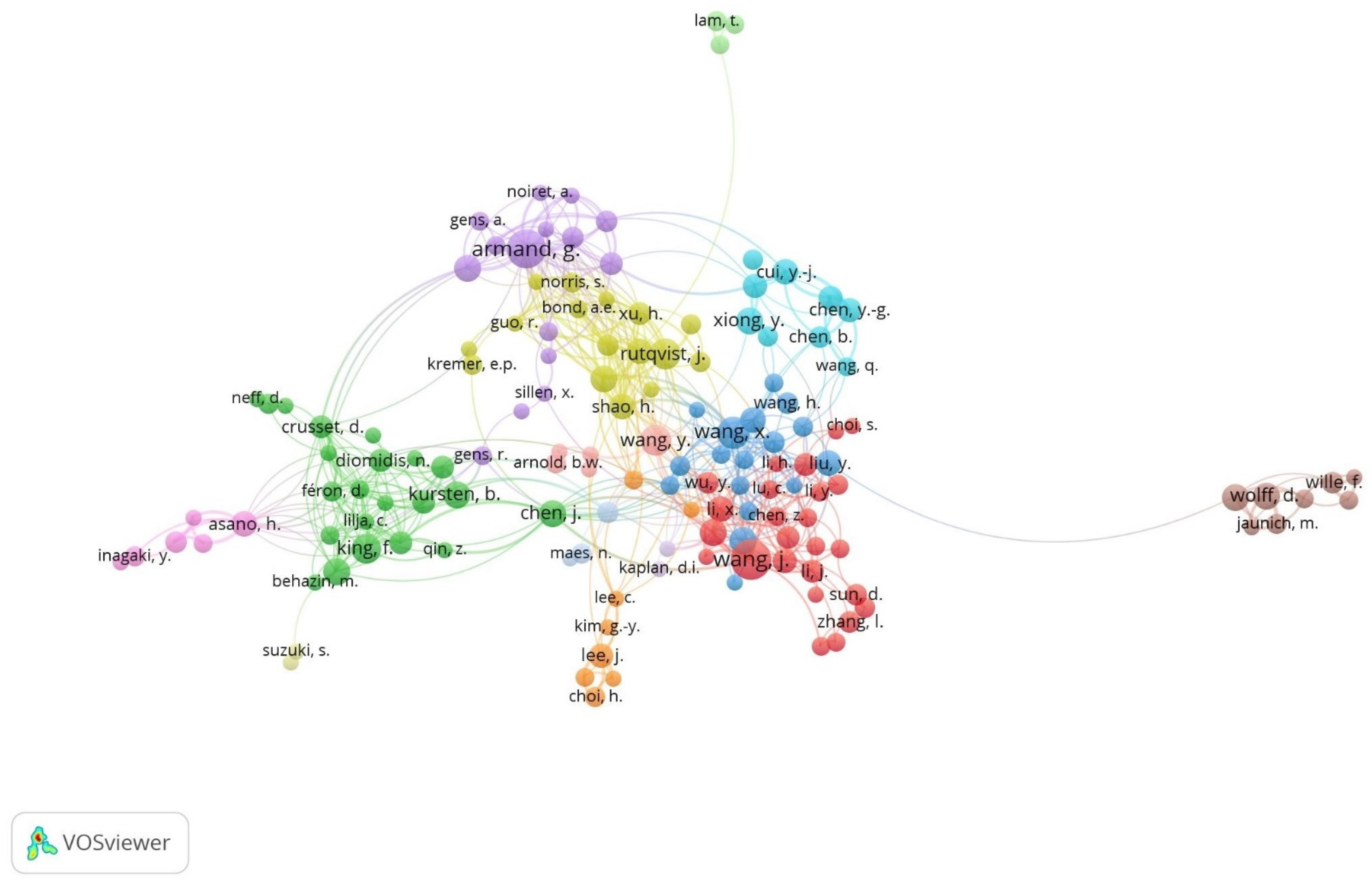

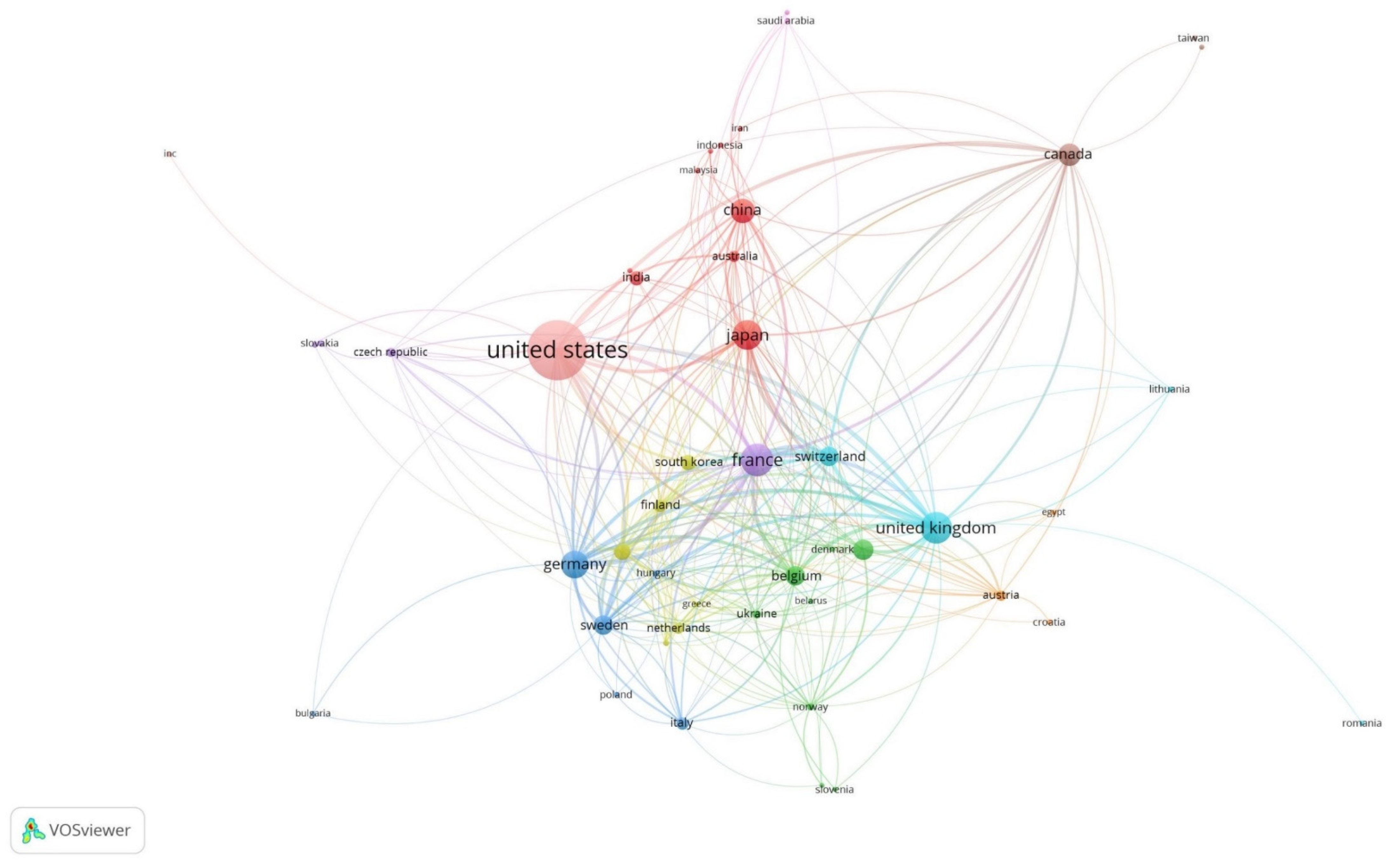
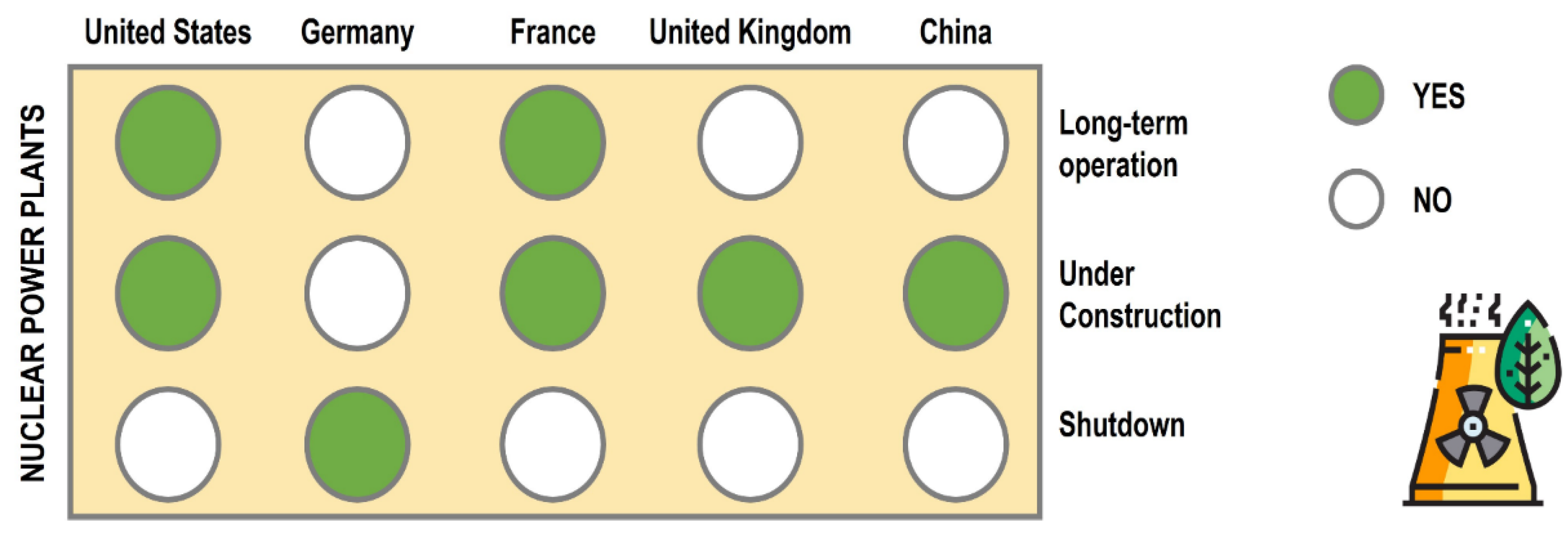

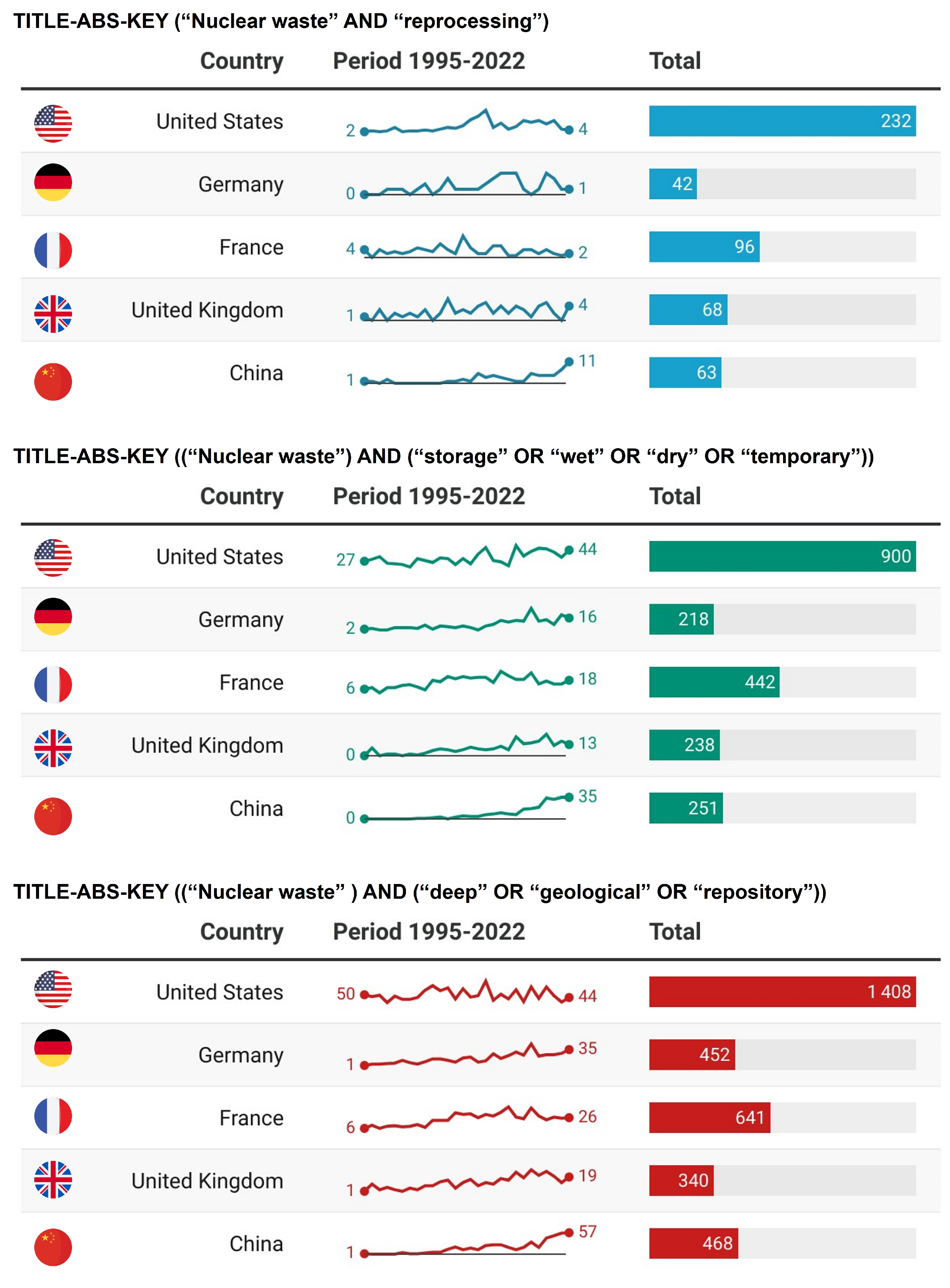
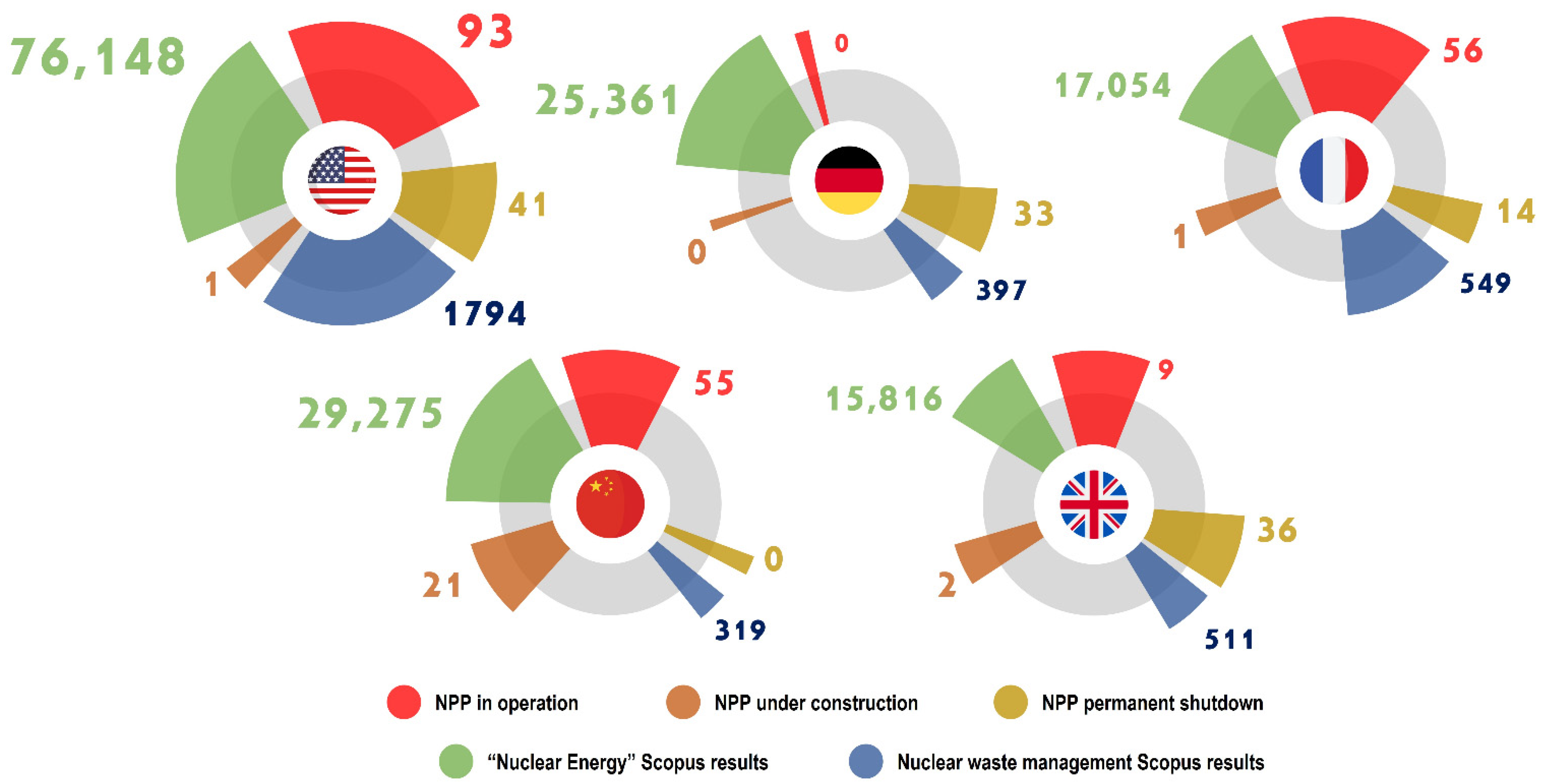
| Technology | Description | Relevant References |
|---|---|---|
| Reprocessing | SF undergoing reprocessing can be separated into three main components: uranium, plutonium, and other wastes. The uranium and plutonium can be reused as nuclear fuel for reactors, while the fission and activation products are wastes, which are vitrified and stored for later handling and disposal. | [22,23,24] |
| Uranium and plutonium reuse | Uranium separated in the previous reprocessing stage can be reused as fuel in reactors. Plutonium can be converted into MOX fuel, in which uranium and plutonium oxides are combined. | [25,26,27] |
| Transport of spent fuel | The management of SL involves several transport steps between different facilities. Transportation activities are used by housing the SF in specially designed containers to ensure its refrigeration, safety, and the protection of workers and the general public. | [28,29] |
| Wet Storage | Most nuclear reactor designs have some form of spent fuel storage pools as an intermediate step. | [30,31,32] |
| Dry Storage | After a period of at least 5 to 10 years, nuclear fuel can be transferred into dry interim storage. | [33,34,35] |
| Temporary Storage | The dry storage facilities are designed for long-term waste. The site should house all HLW and SF. | [36,37,38,39] |
| Deep Geological Repository | An Underground facility is used for disposal of the HLW. It is based on the so-called multibarrier principle. Long-term protection of people and the environment is guaranteed. | [40,41,42] |
| Nuclear Waste–Related Keywords | Approach-Related Keywords | Radioactive Waste Class Keywords |
|---|---|---|
| Nuclear waste, spent fuel, spent nuclear fuel, and radioactive waste | Management, prediction, predicting, forecasting, program, practices, and technologies | High level, high-level, long term, long-range |
| Search String |
|---|
| TITLE-ABS-KEY (“nuclear waste” OR “spent fuel” OR “spent nuclear fuel” OR “radioactive waste”) AND (“management” OR “prediction” OR “predicting” OR “forecasting” OR “program” OR “practices” OR “technologies”) AND (“high level” OR “high-level” OR “long term” OR “long-term” OR “long range” OR “long-range”) |
| Source Type | Number | Percentage |
|---|---|---|
| Journal | 3106 | 49.76% |
| Conference Proceeding | 2507 | 40.16% |
| Book | 251 | 4.02% |
| Trade Journal | 166 | 2.66% |
| Book Series | 163 | 2.61% |
| Other | 49 | 0.79% |
| Total | 6242 | 100% |
| Ranking | Source Title | Number | Percentage |
|---|---|---|---|
| 1 | Proceedings of the international conference on radioactive waste management and environmental remediation ICEM | 342 | 5.48% |
| 2 | Materials research society symposium proceedings | 237 | 3.79% |
| 3 | Nuclear technology | 117 | 1.87% |
| 4 | High level radioactive waste management | 100 | 1.60% |
| 5 | High level radioactive waste management proceedings of the annual international conference | 86 | 1.37% |
| 6 | Nuclear engineering and design | 72 | 1.15% |
| R | Area | Results | Percentage |
|---|---|---|---|
| 1 | Engineering | 2802 | 44.88% |
| 2 | Environmental Science | 2040 | 32.68% |
| 3 | Energy | 1940 | 31.07% |
| 4 | Physics and Astronomy | 1016 | 16.27% |
| 5 | Earth and Planetary Sciences | 953 | 15.27% |
| R | Country | Results | % of 6242 |
|---|---|---|---|
| 1 | United States | 1794 | 28.74% |
| 2 | France | 549 | 8.79% |
| 3 | United Kingdom | 511 | 8.18% |
| 4 | Japan | 466 | 7.46% |
| 5 | Germany | 397 | 6.36% |
| 6 | China | 319 | 5.11% |
| 7 | Canada | 271 | 4.34% |
| 8 | Russian Federation | 218 | 3.49% |
| 9 | Belgium | 201 | 3.22% |
| 10 | Sweden | 193 | 3.09% |
| Search String | Results |
|---|---|
| TITLE-KEY-ABASTRACT (“Nuclear waste” AND “reprocessing”); | 936 |
| TITLE-KEY-ABSTRACT ((“Nuclear waste”) AND (“storage” OR “wet” OR “dry” OR “temporary”)) | 3971 |
| TITLE-KEY-ABSTRACT ((“Nuclear waste”) AND (“deep” OR “geological” OR “repository”)) | 6434 |
Disclaimer/Publisher’s Note: The statements, opinions and data contained in all publications are solely those of the individual author(s) and contributor(s) and not of MDPI and/or the editor(s). MDPI and/or the editor(s) disclaim responsibility for any injury to people or property resulting from any ideas, methods, instructions or products referred to in the content. |
© 2023 by the authors. Licensee MDPI, Basel, Switzerland. This article is an open access article distributed under the terms and conditions of the Creative Commons Attribution (CC BY) license (https://creativecommons.org/licenses/by/4.0/).
Share and Cite
Fernández-Arias, P.; Vergara, D.; Antón-Sancho, Á. Global Review of International Nuclear Waste Management. Energies 2023, 16, 6215. https://doi.org/10.3390/en16176215
Fernández-Arias P, Vergara D, Antón-Sancho Á. Global Review of International Nuclear Waste Management. Energies. 2023; 16(17):6215. https://doi.org/10.3390/en16176215
Chicago/Turabian StyleFernández-Arias, Pablo, Diego Vergara, and Álvaro Antón-Sancho. 2023. "Global Review of International Nuclear Waste Management" Energies 16, no. 17: 6215. https://doi.org/10.3390/en16176215
APA StyleFernández-Arias, P., Vergara, D., & Antón-Sancho, Á. (2023). Global Review of International Nuclear Waste Management. Energies, 16(17), 6215. https://doi.org/10.3390/en16176215








